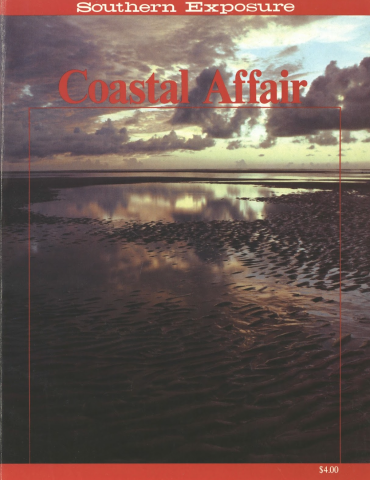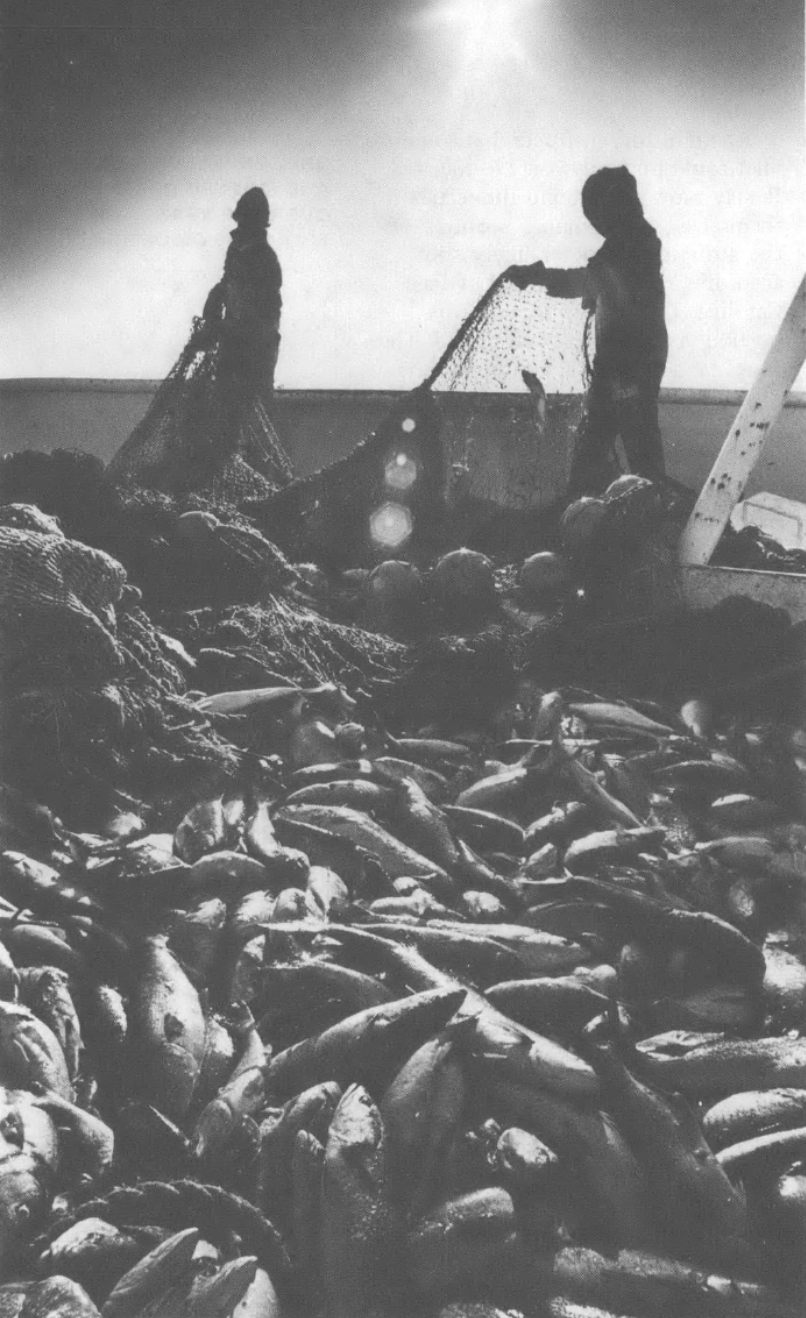
This article originally appeared in Southern Exposure Vol. 10 No. 3, "Coastal Affair." Find more from that issue here.
OREGON INLET is the only sea-to-sound pass for almost 100 miles of Outer Banks, the only break from Cape Henry, Virginia, south to Cape Hatteras. Pounding surf and ripping tidal currents make this inlet the most dynamic on the entire East Coast. As part of the larger migrating barrier island system, Oregon Inlet is constantly changing, shoaling in its boat channel as it moves southward, and making navigation risky.
Testimony to the inlet’s migratory nature is the high arching bridge that crosses it, a silent, expensive mistake reaching across more land now than water. Already, keeping the bridge in place has cost several times its original 1962 construction price. And keeping the dredged boat channel positioned beneath the bridge’s highest span has proved a constant challenge.
How to make Oregon Inlet safe for travelers without hindering its essential natural movement is the subject of considerable debate, with the U.S. Army Corps of Engineers and most ocean-going commercial fishers on one side, and geologists, marine scientists and the U.S. Interior Department on the other. The Corps believes a system of mile-long jetties would stabilize the inlet and minimize the continuous dredging now required to keep the channel open. The other side, pointing to a body of knowledge about the behavior of inlets and islands, contends the jetties would do more harm than good, and might even increase navigational hazards through the inlet.
Behind the Corps’ engineers are a sizable bureaucracy, vested interests and almost $15 million already appropriated by Congress toward the jetties’ estimated cost of $101 million. But geologists and marine scientists have nature on their side, and with an administration that hoards money now in place in Washington, their arguments against the jetties are winning powerful new friends.
The debate gets down to the basics of why inlets through barrier islands exist in the first place.
INLETS – NATURE'S BLOWOUT
The Outer Banks are long narrow accumulations of sand formed thousands of years ago far out on the edge of the continental shelf. As glaciers from the last Ice Age melted, rising sea level caused the islands to migrate shoreward. Over a period of 1,000 years, the Outer Banks moved inward some 40 miles. Sea level rise, sand supply, wave energy and the shape of the offshore sea floor (which affects the nature of the waves that strike the shore) are all responsible for the islands’ individual configurations.
Inlets between islands usually form during major storms, hurricanes or persistent northeasters. As a storm approaches, water piles into the sounds behind the barrier islands; with the passage of the storm and the seaward shift of the wind, this high water surges toward the sea at a catastrophic rate. The flow follows the path of least resistance. Normally that path is through existing inlets which may widen and deepen in a matter hours to accommodate the huge discharge. Oregon Inlet, for example, widened from one-half mile to two miles in a 24-hour time span during the March, 1962, “Ash Wednesday” storm.
Sometimes, however, the water floods across a narrow low point on the island and forms a new inlet. A new inlet may silt back in fairly quickly, but if it provides a more efficient passageway than an older inlet, it will remain open while the old one fills with sand.
Oregon Inlet was first documented on maps in 1585, but closed from 1795 to 1846. In September, 1846, it reopened during a hurricane and was named for one of the first boats to pass through, the steamer Oregon.
Geologists have discovered evidence that at least 14 different inlets — short-term and long-term — have existed in historic times from Hatteras Inlet to the Virginia line. A new one could form at any time.
Once opened, some inlets stay in one place while others tend to migrate laterally. Oregon Inlet has migrated south over two miles since 1846. Longshore currents transfer sand along the coast, dropping their load on the upstream side of inlets and picking up more sand on the downstream side. Thus, the inlet channel moves south as well. Two early lighthouses built on the south side of Oregon Inlet fell victim to erosion, while the Bodie Island light on the north side now stands about a mile from the inlet channel it is supposed to mark for passing boats.
WHAT'S WRONG WITH JETTIES?
Jetties block the natural flow of sand along beaches. The Oregon Inlet jetty design would block this southerly longshore drift and accelerate erosion to the south. Such erosion is of special concern because the 6,000-acre Pea Island National Wildlife Refuge occupies the island to the south. At times, the longshore movement of beach sand reverses direction. When that happens, the national park land north of the inlet, Bodie Island, will also experience accelerated erosion.
One point of contention between other scientists and the Corps’ engineers is the sand bypassing system included in the jetties project design. The bypass system, supposedly, would periodically (every year or two) dredge sand from the upstream side of the jetties and pass it to the downward side, to prevent the inlet’s natural migration. But much of the natural erosion and transport of sand on these islands occurs in a matter of hours during storms. Barrier island scientists doubt any dredge could keep up with nature’s capacity to move sand during a storm. Furthermore, the sand bypass system hinges on a large engineering question mark. The bypass dredges are to work behind a newly designed floating breakwater that has yet to be tested anywhere, particularly in this most dynamic of inlets.
The jetty system, geologists and marine scientists contend, would constrict the inlet’s width and destroy most of its ability to act as a safety valve during storms. Jetties will cork the outgoing rush of inland waters and a new blowout will occur, they say with certainty. The only question is where.
Island history instructs that a new inlet could form anywhere in the area. It may blow out around the jetties themselves, undermining portions of the structure. Another likely spot, according to Dr. Stan Riggs of East Carolina University, is a narrow portion in the town of Nags Head. The Pea Island Refuge is another prime possibility.
To top it off, there is no assurance that the jetties will actually succeed in making the inlet safe for navigation. Barnegat Inlet in New Jersey is used by almost half of the state’s 40,000 fishing and pleasure boats. But jetties constructed there in the 1940s, supposedly to create a safer channel and reduce the need for constant dredging, have not stopped the channel from shifting and shoaling, and numerous boats run aground on the jetties themselves. The Corps had to return to its previous role of extensive dredging in Barnegat Inlet.
Elsewhere, too, jetties have created new problems instead of solving old ones. Shortly after the Corps “stabilized” Masonboro Inlet near Wrightsville Beach, North Carolina, the inlet channel migrated toward the jetty and navigators literally found themselves up against the wall when trying to pass to and from the ocean.
Critics of the proposed Oregon Inlet jetties also point out that the Corps has failed to determine the nature of the substrata underlying the project and lacks sufficient oceanographic data to predict long-range effects accurately. Their attempts to confer with the Corps were persistently rebuffed.
In 1979 the National Park Service empaneled five internationally prominent shoreline geologists and engineers to evaluate the jetty proposal. The panel, headed by Dr. Douglas Inman of Scripps Institution of Oceanography, came down unanimously against jetty construction. The Corps criticized the panelists’ conclusion, saying they had not seen all the available data. So the Park Service reconvened the panel in 1980; its members traveled to the Corps’ Wilmington, North Carolina, office but were denied access to details of the jetty plans. Instead, they were treated to an insulting dog-and-pony show meant for the local Rotary Club, not the top scientists in the field. Subsequently, the North Carolina Academy of Sciences passed a resolution expressing deep concern over the Corps’ reaction to the panel. And outraged marine scientists bypassed the Corps entirely, relaying their objections directly to the Interior Department.
REINING IN THE CORPS
The Park Service’s conclusion, shared by other jetty opponents, is that an improved dredging program would make Oregon Inlet safer for navigation and at the same time would cost less and do less environmental damage than the jetties. For now, the Park Service has stalled jetty construction by denying permits to carry out the project on the park lands which border the inlet. Attempts in Congress and by the Corps to overturn the Park Service’s action by “authorizing” the Department of Interior to surrender the land in question or issue the necessary permits ran into the 1982 federal-level budget-cutting fever, as well as Interior Secretary James Watt’s instructions that dredging alternatives be resurrected and reconsidered by all parties.
Since the Corps has publicly concluded that the situation boils down to jettying the inlet or accepting continued danger to the fishing fleets that use it, local opinion has turned against the Park Service, Interior Department, Fish and Wildlife Service and geologists and marine scientists in general, all of whom are now classified as members of the species “environmentalist” who care more about birds and beaches than human life. Recently the Corps district office in Wilmington went so far as to “solve” the inlet problem by declaring — in the face of all conflicting scientific evidence — that island migration does not occur; thus the jetties will do no basic geologic or ecologic damage to the Outer Banks system.
The truth is that jettying one high wave-energy component of the islands’ sand-and-water-sharing system would result in great economic and environmental loss to the American taxpayer and the vacationer on these beautiful parklands. Plus, the jetties raise false hopes of safety. They would reverse the National Park Service’s decade-old commitment not to combat nature on national seashores. Since the Park Service will not allow the jetties to be built unless ordered to do so by Congress, at issue here too is a possible precedent for removing land from its protected status within national park systems. And, most significantly, the stabilization of Oregon Inlet would obligate future generations to pay for the string of eco-disasters sure to follow.
Tags
Orrin H. Pilkey Jr.
Dr. Orrin H. Pilkey, Jr., is a geology professor at Duke University, co-author of The Beaches Are Moving and other books on island geology and developmental conflicts. He is currently coordinating and co-editing with Dr. William Neal a national state-by-state series of books on “safe,” “unsafe” and “dangerous” beachfront developments. Dr. William J. Neal currently teaches geology at Grand Valley State College in Michigan.
William J. Neal
Dr. Orrin H. Pilkey, Jr., is a geology professor at Duke University, co-author of The Beaches Are Moving and other books on island geology and developmental conflicts. He is currently coordinating and co-editing with Dr. William Neal a national state-by-state series of books on “safe,” “unsafe” and “dangerous” beachfront developments. Dr. William J. Neal currently teaches geology at Grand Valley State College in Michigan.

